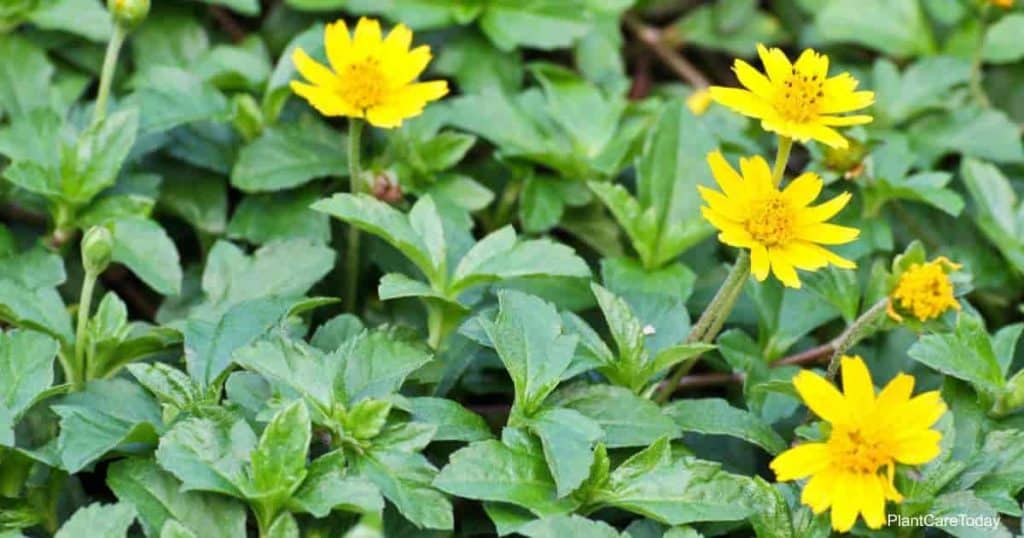Wedelia or Sphagneticola trilobata (sfag-net-TEE-koh-luh try-lo-BAY-tuh) is known by the common name of:
- Singapore Daisy
- Creeping Oxeye
- Trailing Daisy
- Bay Biscayne

This perennial herb is a member of the Composite flower family Asteraceae and hails from:
- Central America
- The Caribbean
- Mexico
This plant has spread throughout the state of Florida, but it is common in southern and central Florida.
Size & Growth
The trailing vines of individual plants grow to be a couple of feet long.
There is no limit to the potential spread of the plant. It will reproduce, grow and spread wherever there is space.
Wedelia leaves are fleshy and 2” and 4” inches in length. They range from 1” inch width to 5” inches, and they have irregularly toothed margins. The foliage has rounded stems.
Flowering
Bay Biscayne’s pretty, daisy-like flowers are yellowish orange and have hairy stems. There are between 8 and 13 florettes on each stem.
The yellowish orange, 1” inch wide flowers grow on stems rising above the dense mat of greenery.
In a tropical setting, Trilobata will bloom year-round.
Light & Temperature
This invasive plant thrives in part shade to full sun. The plant is winter hardy in USDA hardiness zones 8 through 11. [source]
Watering & Feeding
Wedelia once established does well with little or no water or lots of water.
Fertilizing is unnecessary, and in most instances, discouraged.
Soil & Transplanting
Trailing Daisy prefers moist conditions. But, this weedy plant grows well in almost any soil.
Transplanting is easy as the plant will grow well from any bit of plant tissue that comes in contact with soil.
Grooming & Maintenance
Keep the plant well pruned and under control. Dispose of trimmings extremely carefully to prevent having them take root and overrun your local dump. Burning is recommended.
Do not mow or otherwise cut back Trailing Daisy in a way that will allow stems, leaves or other parts of the plant to fall to the ground. They will immediately take root and spread with wild abandon. [source]
How To Propagate Wedelia Trilobata
The plant spreads through nodes which root just below the surface of the soil. Seeds are few and usually not viable.
Wedekia Daisy is extraordinarily easy to propagate. Any tiny part of it will take root in any soil and will grow into a new plant rapidly and enthusiastically.
Sphagneticola Pests or Diseases
For the most part, S. trilobata is resistant to pests. Under some circumstances, mites and leaf hoppers may cause minor damage. In tropical settings, the banana rind thrip may eat stems, leaves and flowers and may cause unsightly silvery lesions, which become brown.
Is Wedelia Considered Toxic Or Poisonous?
This plant is generally considered non-toxic; however, it is worth noting that it has quite a few uses in folk medicine and should be handled accordingly.
It is not an edible plant and should not be eaten by pets, livestock or children.
Is The Plant Considered Invasive?
Creeping Oxeye was introduced to Florida early in the 1900s. Today it is listed by the Florida Exotic Pest Plant Council (FLEPPC) as a Category II invasive species.
Wedelia is invasive and is recognized as a weed throughout Florida and in many countries around the world. This plant is a real threat to agricultural areas, and it spreads rapidly over disturbed ground, abandoned sites, trails, roadsides, ditches and streams.
The plant forms a very dense thicket of leaves and vines which crowd out native species and agricultural crops.
To get rid of Bay Biscayne, you must uproot it carefully and thoroughly. Be sure to remove all rhizomes and roots. Follow-up by applying glyphosate (Round Up) to the entire area.
Check back multiple times to be certain that you have killed the plant off. If it comes back, re-treat the entire area with glyphosate.
For small, unwanted patches of Trailing Daisy, you can use a 2% glyphosate solution. For a large infestation, go with a 5% solution. In some instances, a 1% – 2% solution of Triclopyr can be effective.
Suggested Sphagneticola Trilobata Uses
Because this plant is considered invasive just about everywhere it goes, using it in your garden is typically not a good idea.
If you are going to use it, keep it in a very contained area such as a hanging basket, planter or other container.
Creeping Oxeye can be used as a thick, rapidly growing groundcover, but you must take great care to prevent its spread.